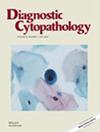A Comparison of Different Transfer Techniques in Evaluating Specimen Adequacy in FNAB: An Unexplored Topic
Abstract
Introduction
This study compared two conventional smear methods during FNAB: The method where the green part of the syringe is touched to the slide (Technique 1) and the method where the contents are rapidly sprayed (Technique 2). We investigated differences in specimen adequacy, diagnostic outcomes, and variations among pathological subgroups.
Methods
FNAB was performed on 128 lesions from 119 patients, and the samples were classified according to the Bethesda System. The two transfer techniques were compared in terms of cell count and diagnostic results.
Results
Of the 128 lesions, 93 were diagnosed as adenomatous nodules. No significant difference was found in the nondiagnostic result rates between the methods. The p-value was found to be 0.65. The average cell count in Technique 1 was 1.95 (min: 0, max: 3+, SD: 1.03), while in Technique 2 it was 1.91 (min: 0, max: 3+, SD: 1.07). Although Technique 1 resulted in a slightly higher positive cell detection, the two techniques were not superior to each other in terms of cell count. The p-value was found to be 0.87. When both techniques were used together, more diagnoses could be made in more patients compared to when each technique was used separately. However, statistically, the combined use of both techniques was not superior to Technique 1 (p = 0.16) or Technique 2 (p = 0.083).
Conclusion
Both techniques showed similar nondiagnostic rates. Technique 1 resulted in a slight increase in the average positive cell count, whereas Technique 2 may be preferred due to its simplicity and safety. It was also found that neither technique provided a clear superiority over the other, and using both techniques together was not superior to either Technique 1 or Technique 2. In determining standard FNAB procedures and improving diagnostic accuracy, factors such as nodule characteristics and needle caliber, along with smear techniques, should also be considered. Larger-scale studies are necessary to validate these findings and improve FNAB practices.

 求助内容:
求助内容: 应助结果提醒方式:
应助结果提醒方式:


